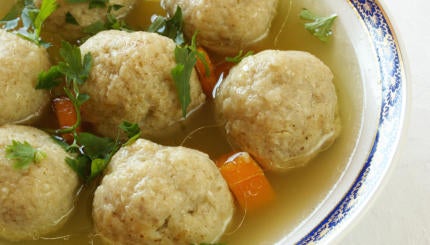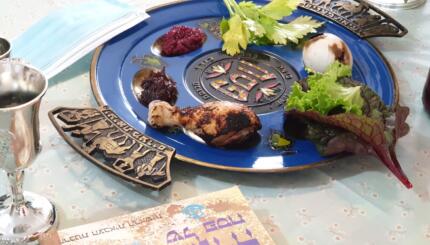Keeping kosher for Passover means abstaining from hametz, the fermented products of five principal grains: wheat, rye, spelt, barley and oats. Though matzah, the unleavened bread eaten on Passover, is made from grain, it is produced under highly controlled conditions to ensure that it does not ferment. All other products made with these grains — even if they appear flat (like crackers and tortillas) — are not kosher for Passover.
Ashkenazi Jews who keep kosher for Passover have also traditionally avoided eating kitniyot, a category of foods that includes corn, rice, beans and lentils, though the Conservative movement’s rabbinic authorities overturned the kitniyot prohibition in 2015. Sephardi Jews do not abstain from kitniyot. A minority of Jews add an additional stringency by avoiding “gebrochts” — unleavened matzah products that become wet, such as matzah balls or matzah meal.
Many Jews avoid most processed food that is not explicitly labeled kosher for Passover. This is true even for products like cheese or juice that do not contain any hametz, but may have been processed in a plant alongside products containing hametz. Some products that are kosher year-round are modified slightly to be kosher for Passover — most famously Coca-Cola, which substitutes cane sugar for corn syrup in some regions over the holiday and is marked by a distinctive yellow cap.
People commonly wonder if the following products are kosher for Passover:
With your help, My Jewish Learning can provide endless opportunities for learning, connection and discovery.
- Nuts and seeds: These are kosher for Passover but some Jews abstain from a subset — including sesame, mustard, chia, and hemp seeds — because they are regarded as kitniyot.
- Alcoholic drinks: Wine can be made kosher for Passover, if manufactured correctly, and is drunk liberally at the seder. For other liquors, it depends on the ingredients and manufacturing process.
- Non-dairy milks: It depends on the ingredients — almost milk can be made kosher for Passover, oat milk cannot. Soy milk occupies a gray area since soy beans are kitniyot.
- Meat substitutes: Seitan if made of wheat and therefore forbidden. For foods like tofu and tempeh it’s more complicated.
- Quinoa: Most quinoa is considered kosher for Passover.
A guide to kosher for Passover foods is published each year by the Orthodox Union, which also maintains a searchable database of Passover foods on its website. The OU also has information on food products that can be used without explicit Passover certification.
TAKE OUR QUIZ: Is this kosher for Passover?
There are a range of additional practices common to Jews who keep kosher for Passover. Chief among them is ridding the home of any hametz products. This is typically done in the days leading up to Passover when homes are cleaned of all hametz. For hametz products that are too valuable or difficult to discard, it is also possible to sell the hametz to a non-Jew. Generally, a rabbi performs this service on behalf of his congregants and then repurchases the hametz for them when the holiday concludes. In these cases, the seller rarely delivers the food to the purchaser, but instead packs it away.
Making a kitchen kosher for Passover is an elaborate process. Countertop surfaces and sinks are either kashered (made kosher) with boiling water or covered for the duration of the holiday, depending on the material. Metal pots and utensils can usually be kashered with boiling water, and various appliances have their own requirements. The OU has a guide to kitchen preparation.
Given the difficulties involved, many Jews maintain separate Passover cookware, dishes and utensils that are used only during the holiday.
Many Jews who do not follow all these restrictions nonetheless make some dietary changes in honor of the holiday. Some people avoid eating hametz but do not thoroughly purge their kitchens of it, while others cut out bread and pasta, yet continue to eat some traditionally forbidden items.
In recent years, some affluent Jews have opted to avoid the rigors of cleaning their kitchen for Passover by going on special kosher-for-Passover cruises or to kosher-for-Passover resorts. The trend, while costly, not only makes the holiday easier to observe, but often provides a welcome opportunity for an extended family to get together without the burden of having to host and cook for large numbers of guests.
Prep for Passover like a pro with this special email series. Click here to sign up and you’ll receive a series of helpful, informative, and beautiful emails that will help you get the most out of the holiday.
Ashkenazi
Pronounced: AHSH-ken-AH-zee, Origin: Hebrew, Jews of Central and Eastern European origin.
kasher
Pronounced: KAH-sher, Origin: Hebrew, to make kosher, usually referring to dishes, cookware or a kitchen.
kitniyot
Pronounced: kit-nee-YOTE, Origin: Hebrew, meaning "little things," the term here refers to legumes, corn, rice and other non-hametz foods prohibited for use on Passover by some Ashkenazic rabbis in the medieval period. Many Sephardic Jews (and Conservative Jews) do allow them on Passover.
kosher
Pronounced: KOH-sher, Origin: Hebrew, adhering to kashrut, the traditional Jewish dietary laws.
Sephardic
Pronounced: seh-FAR-dik, Origin: Hebrew, describing Jews descending from the Jews of Spain.
hametz
Pronounced: khah-METZ or KHUH-metz, Origin: Hebrew, bread or any food that has been leavened or contains a leavening agent. Hametz is prohibited on Passover.



